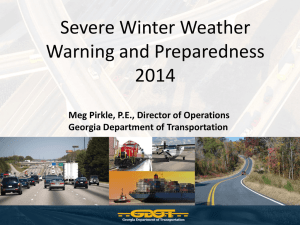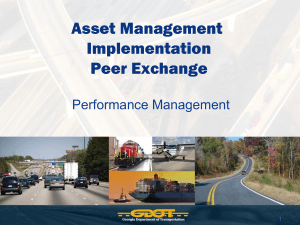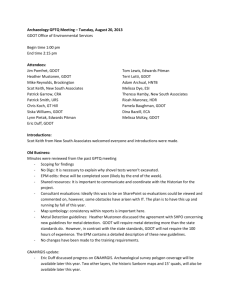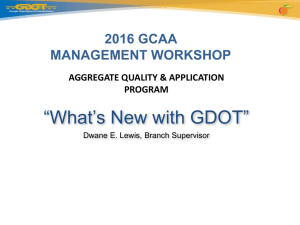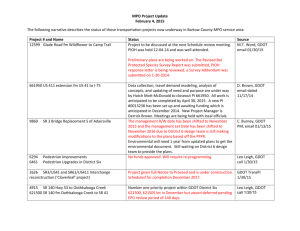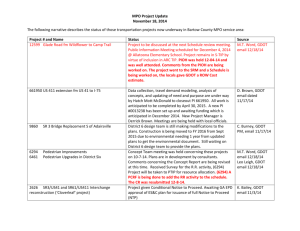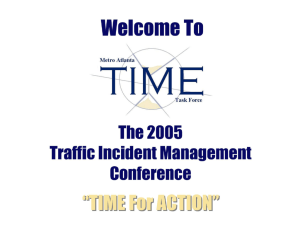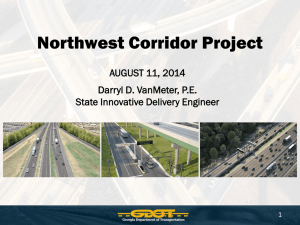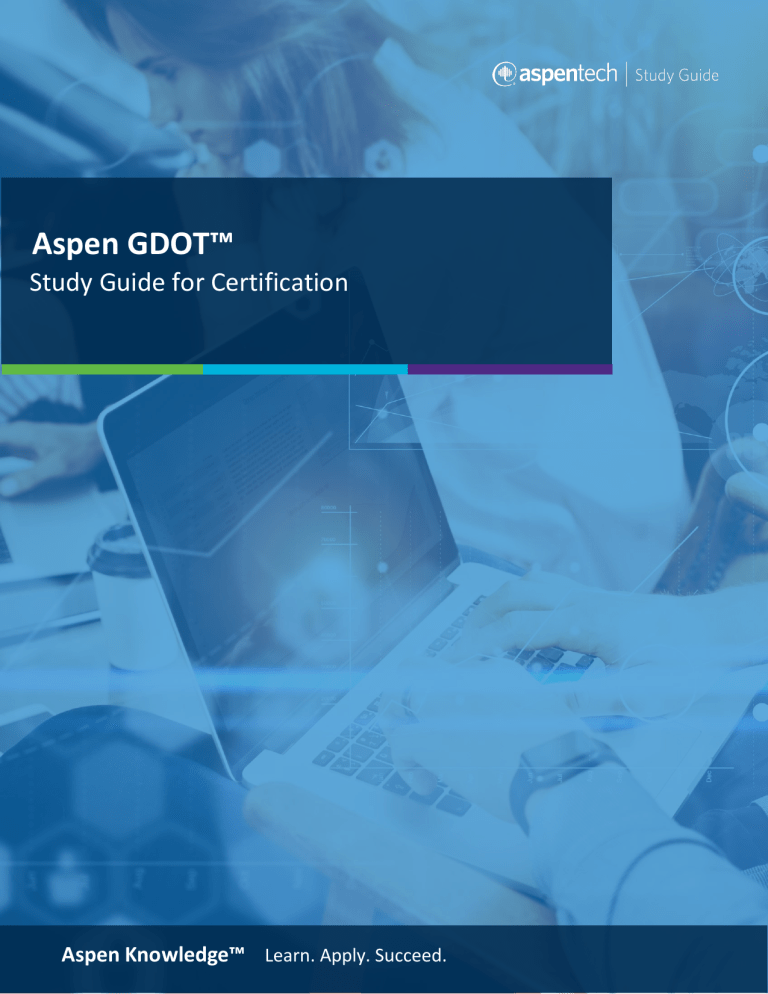
Aspen GDOT™ Study Guide for Certification 1 Aspen Knowledge™ Learn. Apply. Succeed. Prove Your Credibility An Aspen GDOT Certified User has strong understanding of benefits, scope and how Aspen GDOT applications are integrated within the plant along with high level overview on steps required to build Aspen GDOT application. Passing this exam proves that you understand different components available with Aspen GDOT, build and maintain a basic Aspen GDOT application using Aspen GDOT offline tool. Exam Scope for Aspen GDOT □ □ □ □ □ □ □ □ □ □ □ □ □ □ Introduction Infrastructure Opt Objectives Modeling Technique Model Development GDOT Structure Non-Linear Dynamics Optimization Open Equation Model Templates Dynamic Data Reconciliation Model Diagnostic Project Deployment Webserver & Visualizer Mixed Integer Programming Practice Aspen recommends that you attend training through it’s not required. Aspen also recommends that you attend Questions/Answer sessions before exam. This guide contains 100% coverage of all objectives for the certification exam. You can use it as both a study tool and an on-the job reference (see pages 2-5). Get Certified In-person and remote testing are available. Please make sure that you select the correct Location/Time Zone. After passing the exam you will receive an email to post your certificate and digital badge on social media, which is a cross-industry recognition of technical skills you may share on LinkedIn, as well as in your email signature. View the instructions on how to post your credentials on LinkedIn profile. Grading Grade Weight Multiple choice 40% questions 60% Lab task Total 100% AspenTech Call | Email | Chat 1 SCOPE TECHNICAL CONTENT Introduction What is GDOT Infrastructure GDOT Components What are the server requirements for GDOT Opt Objectives Project Overview GDOT Refinery Application Middle Distillate Cluster Naphtha Processing Utility/Hydrogen system Open Equations with Intermediate Feedback GDOT Modeling Techniques Linear Dynamics Optimization (LDO) GDOT Optimizer GDOT Offline Modeling Workflow GDOT Excel Template Register GDOT applications GDOT Model Development Use GDOT console GDOT tunings Input Validation MVC status override Dynamics 2 TEST OBJECTIVE Explain what is GDOT and where does it fit in the operation of the plant Explain key characteristic of a GDOT application Identify type of models can be used in a GDOT application Identify some of the GDOT advantages Identify the execution interval of a GDOT application Describe GDOT application components Explain GDOT software architecture Identify typical Objective of AC&O application Summarize factors that makes solution non-obvious Use the MD GDOT applications Use the Naphtha processing applications Use the Utility/Hydrogen applications Describe the advantages of Open Equation Model Identify the form of the linear model used in GDOT Identify the object function in GDOT Identify the GDOT offline tools Identify the GDOT add-ins Identify the GDOT model development workflow Identify the available GDOT model templates Perform a GDOT registration Use a GDOT console to start and monitor a GDOT application Identify various tunings for a GDOT application Input validation Use MVC status override Enter dynamic information for GDOT model SCOPE GDOT Model Development TECHNICAL CONTENT Transformations Explain the need for transformation Data Flow Identify the data flow of the GDOT applications in a plant information system GDOT Structure Explain how GDOT engine uses various GDOT files Identify sources of nonlinearity File Structure Sources of Non-Linearity GDOT Non-Linear Dynamics Optimization (NLDO) Model Update Distinguish between transformation and NL model Explain the use for moving suppression in a GDOT application Perform a model update GDOT processing cycle Identify the GDOT processing cycle Data centric vs knowledge-based modeling Open model vs Convoluted closed model Distinguish between two approaches Describe the importance of gain ratios in a MIMO system Identify the back-bones models Summarize the advantages of balance rows Identify open model Workflow Use Excel to build a MD GDOT application Multi-Draw Fractionator Perform CDU configuration Blender Perform Blender configuration HydroTreater Perform Hydrotreater configuration What is DR Recognize the need for DR Objective Function for DR Identify the object function for DR Dynamics in DR Purpose of DR Purpose of Model Diagnostic GDOT vs RTO&CLP Recognize the use of Dynamics in DR Identify the purpose for a DR Identify the purpose of Model Diagnostic Distinguish between GDOT and RTO&CLP Workflow Identify the GDOT olefin workflow Identify available models in the GDOT Olefin model template Identify components of the project execution plan Identify sources of benefits Transformation vs NL model Move Suppression Gain Ratio Open Equaton (OE) Back-bones model Linking model sections (balance rows) Model Templates Dynamic Data Reconciliation (DR) Model Diagnostic GDOT Olefin Template Olefin Templates GDOT Project Deployment TEST OBJECTIVE Project Execution plan Benefits 3 SCOPE GDOT Project Deployment TECHNICAL CONTENT TEST OBJECTIVE Requirements Identify the requirements for a successful Model Development Explain the steps for model development Recognize the needs for close communication with planning and scheduling Identify various GDOT web components Distinguish between GDOT console vs GDOT Web Visualizer Explain the use of spare capacity Explain the binary variables in a MIP GDOT application Commissioning Components Web Server & Visualizer Mixed Integer Programming Console vs Visualizer Spare Capacity Binary Variables 4 About Aspen Technology Aspen Technology (AspenTech) is a leading software supplier for optimizing asset performance. Our products thrive in complex, industrial environments where it is critical to optimize the asset design, operation and maintenance lifecycle. AspenTech uniquely combines decades of process modeling expertise with machine learning. Our purpose-built software platform automates knowledge work and builds sustainable competitive advantage by delivering high returns over the entire asset lifecycle. As a result, companies in capital-intensive industries can maximize uptime and push the limits of performance, running their assets safer, greener, longer and faster. Visit AspenTech.com to find out more. © 2020 Aspen Technology, Inc. AspenTech®, Aspen®, aspenONE®, the Aspen leaf logo, the aspenONE logo and OPTIMIZE are trademarks of Aspen Technology, Inc. All rights reserved. AT-05199 5

